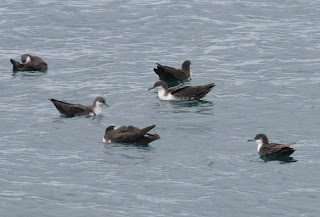Stayed on Santa Cruz today, and as announced paid a return visit to the Highlands. Not exactly the Grampians, but high enough to keep an almost constant flow of moisture dropping out of the sky at this time of year. Looking back at my log for 23/02/2003, I noted "the terrain is arid and in the main Thorn Forest", unlike today when everything was beautifully green with mud on the narrow paths.

Los Gemelos (The Twins)
Puerto Ayora is seeming a little like home, with many people recognising me especially the local police. After breakfast I hopped into a collectivo taxi (pick-up truck) which takes you to the bus station for $1. There is only The Canal bus so it's Hobson's and a standing $1.80 regardless of your destination. Being fairly familiar territory I had some idea of where I was going and what I might see. The bus dropped me at Los Gemelos (The Twins) which are two fairly identical volcanic sinkholes, one either side of the main road, and a magnet for most tourists.

The East Sinkhole

Ditto

Large-billed Flycatcher - just stuck this in to relieve the boredom of sinkholes.
When I arrived there were already 2 coach loads, and you could hear the occupants 2 blocks away. Luckily, I only wanted a fleeting glimpse of the depressions, a photo call then into the forest via a very narrow and muddy path by and large unused. Last time we did get good views of the extremely elusive Dark-billed Cuckoo, but that was no to be today not helped by the now dense vegetation. However, I got straight onto a pair of Woodpecker Finches which were more intent on collecting nesting material than displaying their most unusual feeding technique. Having particularly short tongues, they resort to plucking a twig or cactus needle to prise grubs from tree cavities, often using the same tool over again and adjusting length as requires. Also in attendance were a good number of extremely vocal Warbler Finch, along with all 3 Tree Fiches, Large-billed (Galapagos) Flycatcher, Smooth-billed Ani and the endemic Mockingbird. I was by no means finished, but by mid-day the light drizzly rain had become persistent and so returned to the main road to find a lift 'home'.

The West Sinkhole

Pretty similar aren't they?

Yet another self-portrait
Reaching the road, I found a motorcycle policeman on duty doing traffic checks, who asked if I was returning to town. my Spanish (and Pigeon) is just about good enough now to know that he was willing to organise my ride. Taking the opportunity, I asked if he knew anything about the dead man on the beach last week, and told me it had been the highlight of the year thus far. Turns out he was an ex-military man, married with 2 children (who had been looking for him for 5 days) and had just spent 3 years in jail on San Cristobel for drug abuse. As suspected, he had wandered onto the lava fore-shore, stoned, fallen and hit his head, so it seems the 'Big C' gets you one way or another.
A couple of shots from yesterday.

Great Frigatebird (male)

Great Frigatebird (juvenile) note orange/brown on throat, which often extends over the head.
 First the plunge from the air into the sea.
First the plunge from the air into the sea. Occasionally submerging completely.
Occasionally submerging completely. Failing to capture prey.
Failing to capture prey. Return to the surface,
Return to the surface, and commence a search
and commence a search with head submerged.
with head submerged. The catch, thought large for a 'small' Shearwater!
The catch, thought large for a 'small' Shearwater! After the kill the group took to the air, re-located and continued the chase.
After the kill the group took to the air, re-located and continued the chase. After what was a mini feeding-frenzy the group sat on the sea preening.
After what was a mini feeding-frenzy the group sat on the sea preening.









